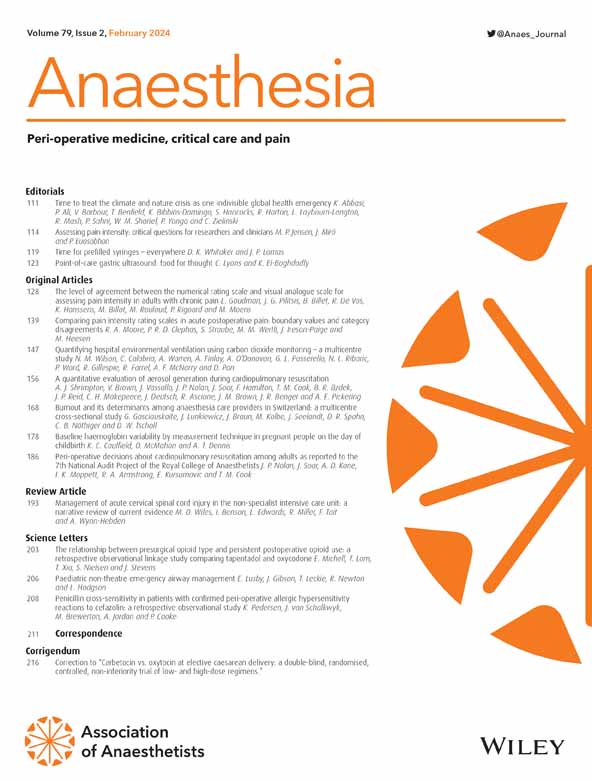Comparison of two peripheral regional analgesic techniques for primary elective total hip arthroplasty: a randomised clinical trial.
IF 7.5
1区 医学
Q1 ANESTHESIOLOGY
引用次数: 0
Abstract
INTRODUCTION Several regional anaesthesia techniques have been used in the peri-operative pain management of patients who undergo primary elective total hip arthroplasty. The erector spinae plane, pericapsular nerve group and lateral femoral cutaneous nerve blocks offer motor-sparing analgesia of the hip region but target different areas. We designed this study to compare the pericapsular nerve group block combined with lateral femoral cutaneous nerve block with the erector spinae plane block in terms of postoperative analgesia and motor impairment. METHODS Our study involved patients undergoing primary elective unilateral total hip arthroplasty. All patients received spinal anaesthesia and standardised peri-operative multimodal analgesia. Patients were assigned at random to either pericapsular nerve group and lateral femoral cutaneous nerve blocks ('anterior' block group) or erector spinae plane block ('posterior' block group). The primary outcome was intravenous morphine consumption within the first 24 h postoperatively. Secondary outcomes included: pain scores; assessment of sensory and motor block; incidence of complications; and incidence of chronic postsurgical pain. RESULTS Sixty-two patients completed the study. The study groups were comparable in baseline characteristics. There was no difference in morphine consumption at 24 h between patients allocated to the anterior and posterior block groups (median (IQR [range]) 5 (1-10 [0-22]) mg vs. 5 (2-8.5 [0-20]) mg, respectively; p > 0.99). Incidence of motor block was 1/31 for patients allocated to the anterior block group compared with 5/31 for those allocated to the posterior block group (p = 0.09). There were no differences in any of the secondary outcome measures between groups. DISCUSSION We found no statistically or clinically relevant difference between two motor-sparing peripheral regional analgesic techniques among patients undergoing primary elective total hip arthroplasty with multimodal analgesia. Appropriate choice of block may be situation-dependent, and physicians should consider patient and system factors when selecting a technique.原发性选择性全髋关节置换术中两种周围区域镇痛技术的比较:一项随机临床试验。
几种区域麻醉技术已被用于原发性选择性全髋关节置换术患者的围手术期疼痛管理。竖脊肌平面、囊周神经群和股外侧皮神经阻滞均可提供髋关节区域的保运动镇痛,但作用区域不同。我们设计了这项研究来比较肩胛神经群阻滞联合股外侧皮神经阻滞与竖脊平面阻滞在术后镇痛和运动损伤方面的效果。方法本研究纳入了接受原发性选择性单侧全髋关节置换术的患者。所有患者均行脊髓麻醉和标准化围手术期多模式镇痛。患者被随机分配到包膜神经组和股外侧皮神经阻滞组(“前”阻滞组)或竖脊肌平面阻滞组(“后”阻滞组)。主要观察指标为术后24小时内静脉注射吗啡用量。次要结局包括:疼痛评分;感觉和运动阻滞的评估;并发症发生率;以及术后慢性疼痛的发生率。结果62例患者完成了研究。两个研究组的基线特征具有可比性。前后阻断组24 h吗啡用量无差异(中位数(IQR[范围])分别为5 (1-10 [0-22])mg和5 (2-8.5 [0-20])mg;p > 0.99)。前阻滞组的运动阻滞发生率为1/31,后阻滞组为5/31 (p = 0.09)。两组间的次要指标均无差异。讨论:我们发现两种保留运动的外周区域镇痛技术在首次选择性全髋关节置换术中采用多模式镇痛的患者之间没有统计学或临床相关差异。阻滞的适当选择可能取决于情况,医生在选择技术时应考虑患者和系统因素。
本文章由计算机程序翻译,如有差异,请以英文原文为准。
求助全文
约1分钟内获得全文
求助全文
来源期刊

Anaesthesia
医学-麻醉学
CiteScore
21.20
自引率
9.30%
发文量
300
审稿时长
6 months
期刊介绍:
The official journal of the Association of Anaesthetists is Anaesthesia. It is a comprehensive international publication that covers a wide range of topics. The journal focuses on general and regional anaesthesia, as well as intensive care and pain therapy. It includes original articles that have undergone peer review, covering all aspects of these fields, including research on equipment.
 求助内容:
求助内容: 应助结果提醒方式:
应助结果提醒方式:


